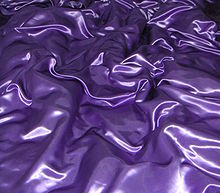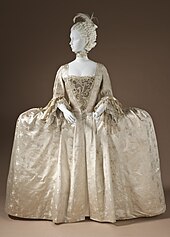

A satin weave is a type of fabric weave that produces a characteristically glossy, smooth or lustrous material, typically with a glossy top surface and a dull back; it is not durable, as it tends to snag. It is one of three fundamental types of textile weaves alongside plain weave and twill weave.
The satin weave is characterised by four or more fill or weft yarns floating over a warp yarn, and four warp yarns floating over a single weft yarn. Floats are missed interfacings, for example where the warp yarn lies on top of the weft in a warp-faced satin. These floats explain the high lustre and even sheen, as unlike in other weaves, light is not scattered as much when hitting the fibres, resulting in a stronger reflection. Satin is usually a warp-faced weaving technique in which warp yarns are "floated" over weft yarns, although there are also weft-faced satins.[1] If a fabric is formed with a satin weave using filament fibres such as silk, polyester or nylon, the corresponding fabric is termed a 'satin', although some definitions insist that a satin fabric is only made from silk.[2] If the yarns used are short-staple yarns such as cotton, the fabric formed is considered a sateen.
Many variations can be made of the basic satin weave, including a granite weave and a check weave.
Satin is commonly used in clothing, for items such as lingerie, nightgowns, blouses, and evening gowns, but is also used for boxer shorts, shirts and neckties. It is also used in the production of pointe shoes for ballet. Other uses include interior furnishing fabrics, upholstery, and bed sheets.

|
See also: History of silk |
Satin was originally made solely of silk, which, for much of history, was produced and found mainly in China.[3] In ancient[clarify] China, there were various forms of satin fabrics which came under several names, such as duan (缎), zhusi (紵丝), ling (绫), jin (锦), wusi (五丝) and basi (八丝).[4] Chinese satin, in its original form, was supposed to be a five- or six-end warp satin.[4] The six-end warp satin weave was mostly likely a derivative of the six-end warp twill weave during the Tang and Northern Song dynasty periods.[4]
Silk satin was introduced to Europe during the 12th century.[citation needed] As an imported fabric, it was considerably expensive, and was worn only by the upper classes.
The word "satin" derives its origin from the Chinese port city of Quanzhou (泉州),[4] which was known as Zayton in Europe and Arab countries during the Yuan dynasty (13th–14th century).[5] During that period, Quanzhou was visited by Arab merchants and by Europeans.[5][6] The Arabs referred to silk satin imported from Quanzhou as zaituni.[5] During the latter part of the Middle Ages, Quanzhou was a major shipping port of silk, using the Maritime Silk Road to reach Europe. It was mostly used in the Arab world.
Satin-weave fabrics are more flexible, with better draping characteristics than plain weaves. In a satin weave, the fill yarn passes over multiple warp yarns before interlacing under one warp yarn. Common satin weaves are:[7]
Because of the different ways the weave is employed, satin has a range of functions from interior décor to fashion.